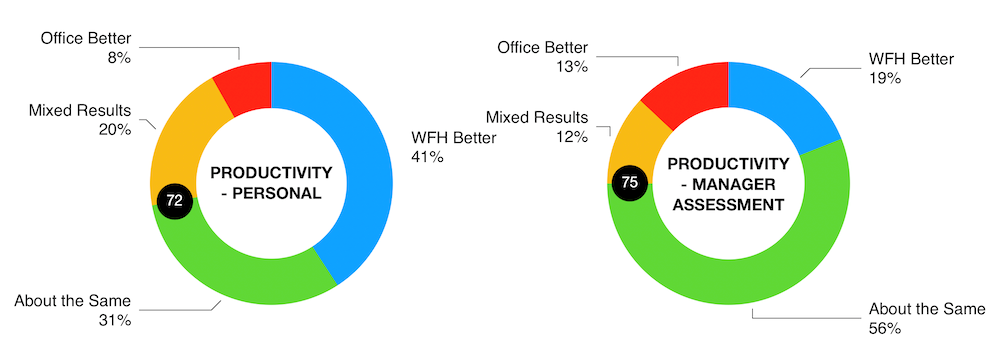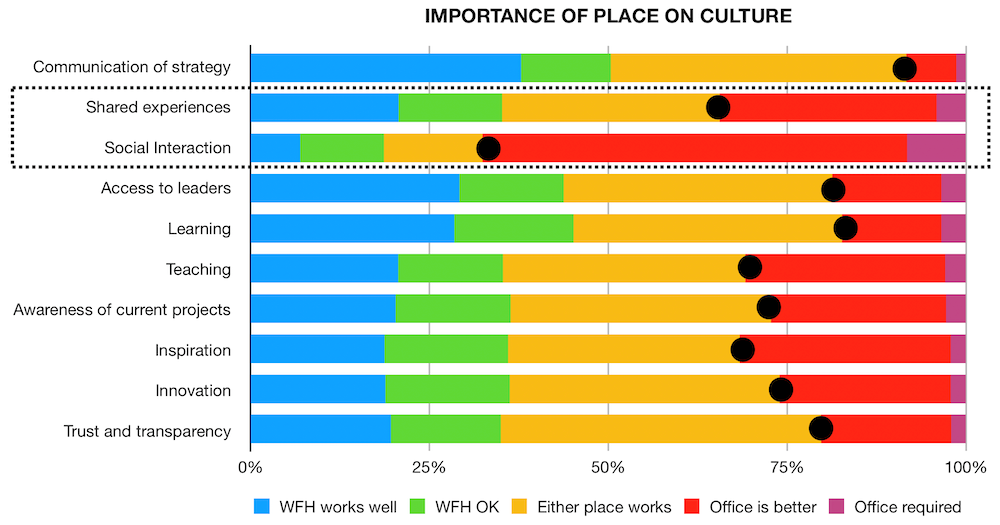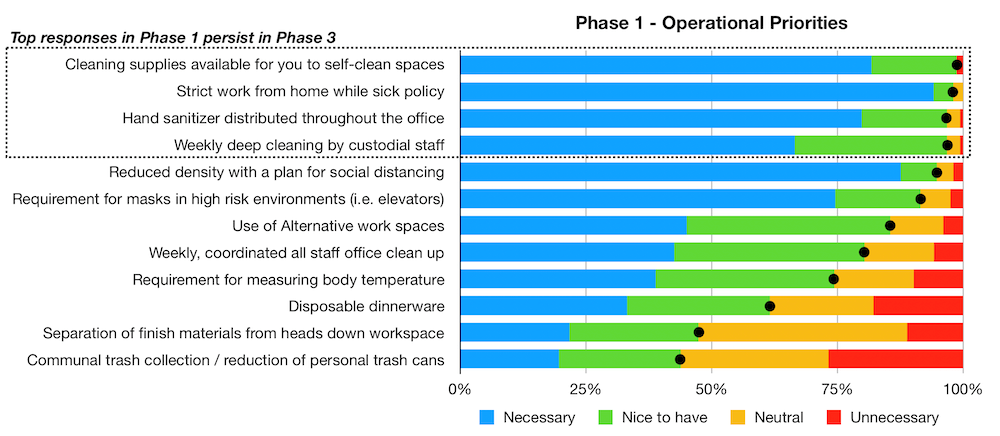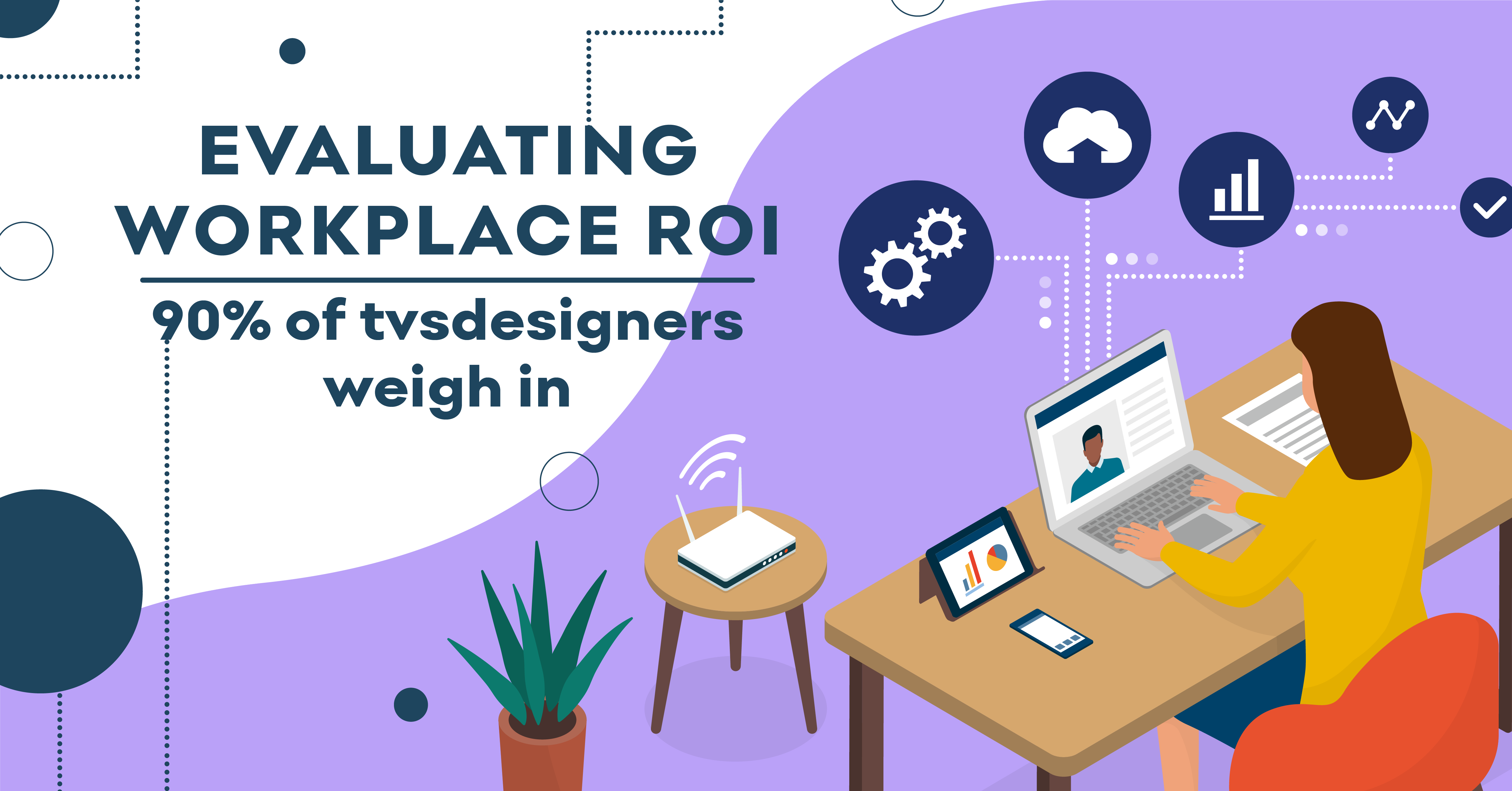|
Before COVID-19, the office was our primary base of operation, the place where our assigned desk was, the place that housed the tools we needed and the people we needed to see. Our technology platform made it possible to work remotely, though few did so on a regular basis – only about 30%
We began working from home (WFH) on Friday, March 13. By the following Monday, our use of MS Teams nearly tripled when managers and leadership joined the conversations already underway between most of the junior staff.
Seven weeks later, 90% of the firm responded to a survey about what we’ve learned, our concerns, changes to our business and vision for the near- and longer-term future of our workplace. We’d like to share some results, insights and plans based on these results and the conversations they sparked.
PRODUCTIVITY – WFH IS WORKING
After the first few weeks, staff had settled into communication rhythms and protocols. By week 7 we were ready to understand how well we were accomplishing our work together. We wanted to know how productivity rated in isolation compared to pre-COVID-19 levels.
Not surprisingly, most people rated their own productivity from home as the same as or better than work from the office before the pandemic. When asked about direct reports, managers rated productivity at 75% the same as or better than work from the office before isolation. Disregarding mixed results related to in-home distractions, there is overwhelming confirmation that the firm is “getting it done” from home.

|
These results are summary results. Our analysis of the demographic trends within the responses shows that middle managers with less than 2 years of experience at tvsdesign represented half of those rating productivity as better in the office. To support new staff, we may need to consider new methods of onboarding and building supporting relationships. We see a new digital work platform as a great step in this direction.
ONLINE CULTURE IS STRONG BUT WE MISS EACH OTHER
Our team showed their comfort with digital communication in questions related to culture by reporting that many of the activities that strengthen our culture work well in a virtual world with a notable exception – We miss each other. We miss the chance to bump into someone and share their day, the chance to hear about successes and challenges and the opportunity to help and share joy. In response, we’re extending a physical program to a digital format. “Forced Friends Breakfast” groups 8 tvsdesigners at random for a time of sharing and problem solving. It seems that WFH will likely be a bigger tool in our tool chest than pre-COVID levels, so more strategies will be necessary to keep our culture thriving in the future.

|
NOT READY TO RETURN – YET
With reported productivity supporting the current work from home strategy, we turned our sights to staff readiness to return and the near-term changes we need to make at the office. When asked about readiness to return before Phase 3, 74% reported that they are not ready to return, with 1 in 5 very concerned as they are in a risk category for COVID-19 or live with someone who is.
PREPARATIONS FOR THE FUTURE WITH OR WITHOUT COVID-19
We asked staff to rate potential preparation measures from now, in Phase 1 of the government guidelines, through Phase 2 and finally ending in Phase 3 (no restrictions). In Phase 1, readily available cleaning supplies, strict work from home while sick rules, masks in risky areas, distributed hand sanitizer, weekly professional cleaning and reduced density, were seen almost universally as necessary or nice to have.

|
In comparing the data across Phases, very little “relaxing” of requirements emerged in Phase 2. And yet, in Phase 3, when restrictions are lifted, predictable relaxing of requirements was identified by staff but strict work from home policies, distributed hand sanitizer, available cleaning supplies and regular professional cleaning remain very important to our team on an ongoing basis.
FUTURE WORKPLACE WON’T BE THE SAME – READY FOR CHANGE
When asked, if up to you, where would you prefer to work, only 29% showed a preference for the office, 23% showed a preference for WFH, with the remaining 48% fall somewhere in between. Senior leaders and most junior staff showed the strongest preference for work in the office. From written commentary, junior staff misses the chance opportunities to learn from those around them. Senior staff finds it more difficult to mentor and teach remotely.
We’re working on digital tools and training to shore up these areas of concern.
|

|
When asked about their views on changes to our workplace, 53% say that the office should be changed to support activities that cannot be successfully done online. Another 31% suggest that WFH may mean a shift in space from dedicated workstations to more collaborative spaces. Only 16% believe the office should be configured in much the same way as before the pandemic. This indicates a significant shift from the trends that emerged from a workplace survey we conducted a year ago in preparation for our new office design. Our staff response shows a desire and a willingness for change.

|
EMERGING VIEW OF ROI FOR OUR OFFICE SPACE
Our firm is actively engaged in problem solving for ourselves and our clients. We are learning the lessons of working remotely and will capitalize on opportunities to reimagine our workplace for a time when we will be able to come back together. Our President, Janet Simpson who is also a workplace strategist, sees our workplace as a LEARNING LABORATORY. We’re studying our survey results to learn which parts of our workflow work best when we are together, which activities may involve both in-person and virtual participants, and what physical, operational and digital strategies we need to use to build trust using the power of place and the benefits of electronic collaboration.
We’ll share more of that story and the experiments we are planning next time.
If you would like to learn more about this survey tool and how we can customize it for your team,
GET IN TOUCH
[/vc_column_text][/vc_column][/vc_row][vc_row][vc_column][vc_column_text] |
|
|










